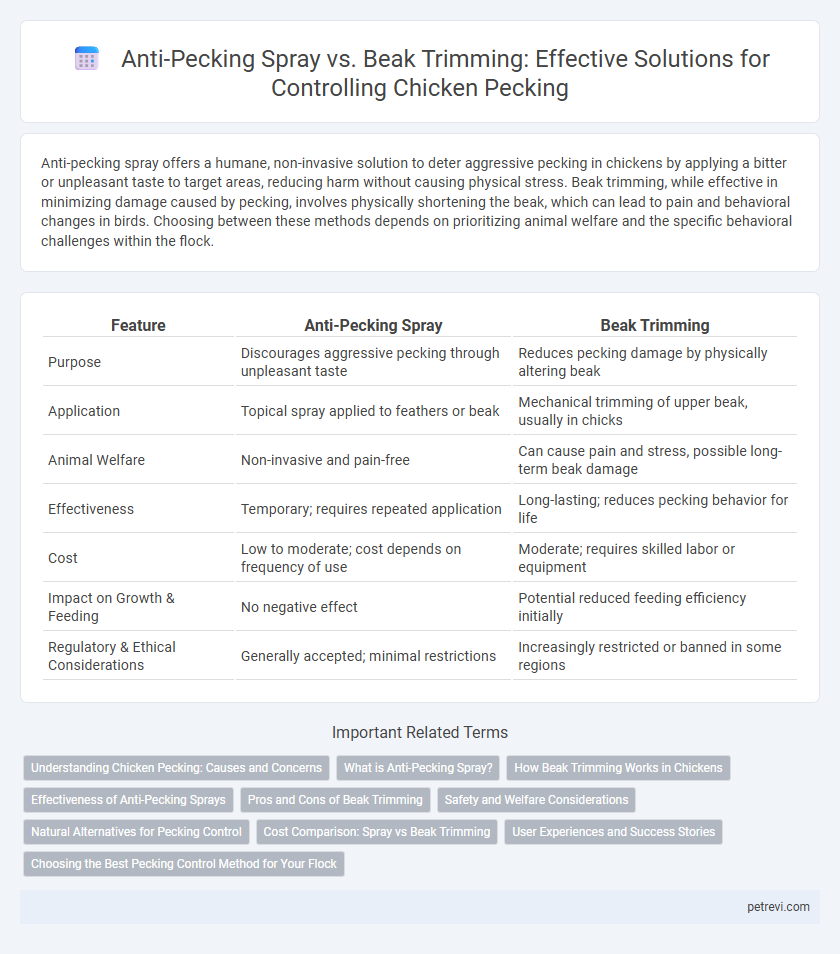Anti-pecking spray offers a humane, non-invasive solution to deter aggressive pecking in chickens by applying a bitter or unpleasant taste to target areas, reducing harm without causing physical stress. Beak trimming, while effective in minimizing damage caused by pecking, involves physically shortening the beak, which can lead to pain and behavioral changes in birds. Choosing between these methods depends on prioritizing animal welfare and the specific behavioral challenges within the flock.
Table of Comparison
| Feature | Anti-Pecking Spray | Beak Trimming |
|---|---|---|
| Purpose | Discourages aggressive pecking through unpleasant taste | Reduces pecking damage by physically altering beak |
| Application | Topical spray applied to feathers or beak | Mechanical trimming of upper beak, usually in chicks |
| Animal Welfare | Non-invasive and pain-free | Can cause pain and stress, possible long-term beak damage |
| Effectiveness | Temporary; requires repeated application | Long-lasting; reduces pecking behavior for life |
| Cost | Low to moderate; cost depends on frequency of use | Moderate; requires skilled labor or equipment |
| Impact on Growth & Feeding | No negative effect | Potential reduced feeding efficiency initially |
| Regulatory & Ethical Considerations | Generally accepted; minimal restrictions | Increasingly restricted or banned in some regions |
Understanding Chicken Pecking: Causes and Concerns
Chicken pecking often arises from stress, boredom, and overcrowding, leading to aggressive behavior that harms flock health and productivity. Anti-pecking sprays use deterrent tastes or scents to discourage pecking without causing physical harm, supporting natural behaviors. Beak trimming, a more invasive method, reduces damage by partially removing the beak but raises welfare concerns due to potential pain and long-term sensitivity.
What is Anti-Pecking Spray?
Anti-pecking spray is a specially formulated solution designed to deter chickens from aggressive pecking by creating an unpleasant taste on their feathers and skin. This non-invasive method helps reduce harmful behaviors without causing physical harm or stress to the birds. Commonly used as an alternative to beak trimming, anti-pecking sprays preserve the natural beak structure while promoting flock harmony.
How Beak Trimming Works in Chickens
Beak trimming in chickens involves removing a portion of the beak to reduce damage caused by pecking behaviors, typically performed in young chicks using infrared or hot blade methods. This procedure limits the bird's ability to inflict harm on flock mates while maintaining essential functions like eating and preening. By modifying the beak structure, beak trimming effectively minimizes aggressive pecking and cannibalism in intensive poultry settings.
Effectiveness of Anti-Pecking Sprays
Anti-pecking sprays offer a non-invasive solution to reduce aggressive pecking behavior in chickens by applying deterrent ingredients that discourage pecking without causing pain or stress. Studies show that these sprays can effectively minimize feather damage and injuries when used consistently in early intervention, although results may vary based on flock size and environmental conditions. Compared to beak trimming, anti-pecking sprays maintain natural behavior while reducing the risk of infection and long-term health issues linked to physical alterations.
Pros and Cons of Beak Trimming
Beak trimming reduces injury and feather loss by limiting a chicken's ability to peck, improving flock welfare and productivity in intensive systems. However, it can cause short-term pain and stress, with risks of improper trimming leading to beak deformities and impaired feeding. Despite these concerns, when performed correctly, beak trimming remains a widely used and effective method for pecking control compared to alternatives like anti-pecking spray.
Safety and Welfare Considerations
Anti-pecking spray offers a non-invasive method to deter aggressive pecking behavior in chickens, promoting welfare by avoiding physical alterations. Beak trimming, while effective in reducing injuries from pecking, raises concerns due to potential pain and long-term welfare impact if not performed correctly or at an early age. Safety considerations prioritize minimizing stress and harm; thus, anti-pecking sprays are often preferred for enhancing humane treatment while still managing pecking issues.
Natural Alternatives for Pecking Control
Anti-pecking sprays offer a natural alternative to beak trimming by using bitter or unpleasant-tasting ingredients to deter chickens from pecking, minimizing stress and promoting welfare without physical alteration. These sprays are often composed of safe, non-toxic substances like herbal extracts, which maintain flock harmony and reduce feather damage. Beak trimming, while effective, can cause pain and behavioral issues, making natural deterrents like anti-pecking sprays a preferred option for ethical pecking control in poultry management.
Cost Comparison: Spray vs Beak Trimming
Anti-pecking spray offers a cost-effective solution for chicken pecking control, with prices typically ranging from $10 to $30 per bottle, covering multiple applications and reducing the need for skilled labor. In contrast, beak trimming involves higher initial expenses, averaging $1 to $2 per bird when accounting for equipment, professional services, and potential stress-related health costs. Long-term financial impact favors anti-pecking sprays due to lower operational costs and minimized adverse effects compared to the one-time but invasive beak trimming procedure.
User Experiences and Success Stories
Users report that anti-pecking spray offers a non-invasive, stress-free solution for controlling aggressive pecking in chickens, with many praising its ease of application and immediate deterrent effect. Beak trimming, while effective in reducing pecking injuries, often raises concerns about animal welfare and requires skilled handling to avoid harm. Success stories highlight that combining anti-pecking sprays with environmental enrichment reduces overall pecking behavior more sustainably than beak trimming alone.
Choosing the Best Pecking Control Method for Your Flock
Choosing the best pecking control method for your flock involves weighing the effectiveness and welfare impacts of anti-pecking spray and beak trimming. Anti-pecking sprays provide a non-invasive deterrent by applying bitter or unpleasant-tasting substances to reduce aggressive pecking without causing lasting physical harm. Beak trimming, although more permanent in reducing feather pecking and cannibalism, requires careful execution by trained personnel to minimize pain and stress in chickens.
Anti-Pecking Spray vs Beak Trimming for Chicken Pecking Control Infographic

 petrevi.com
petrevi.com